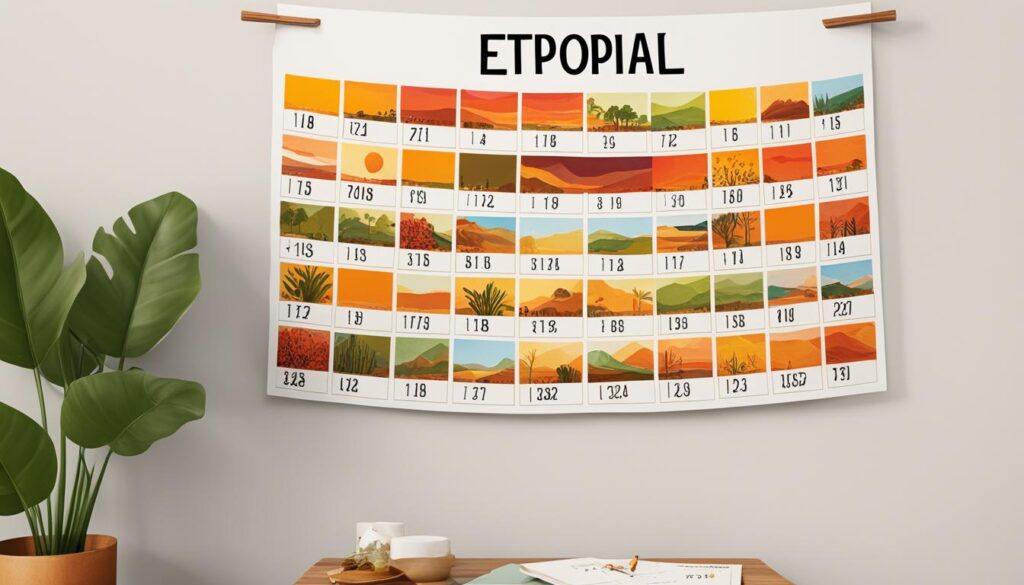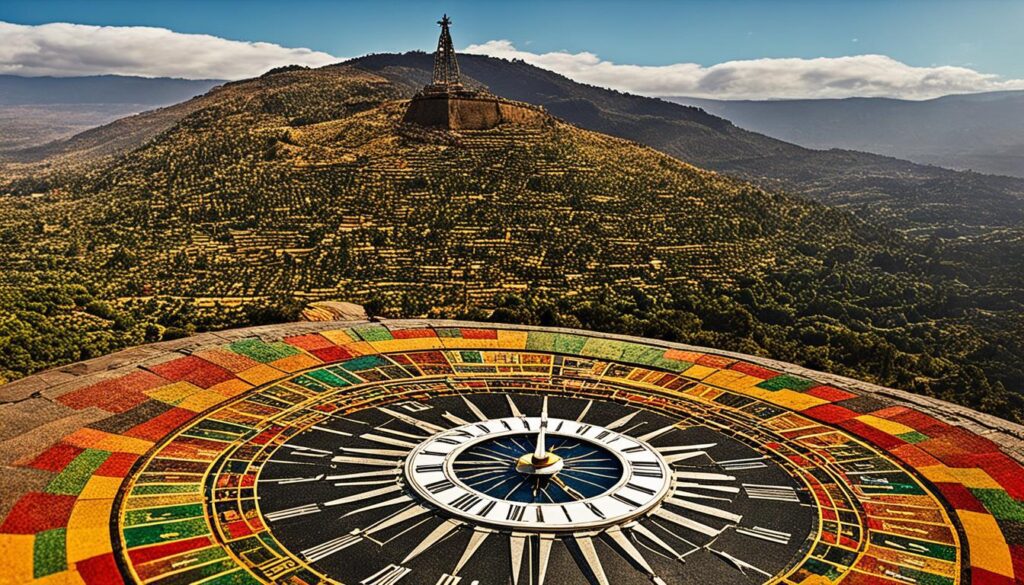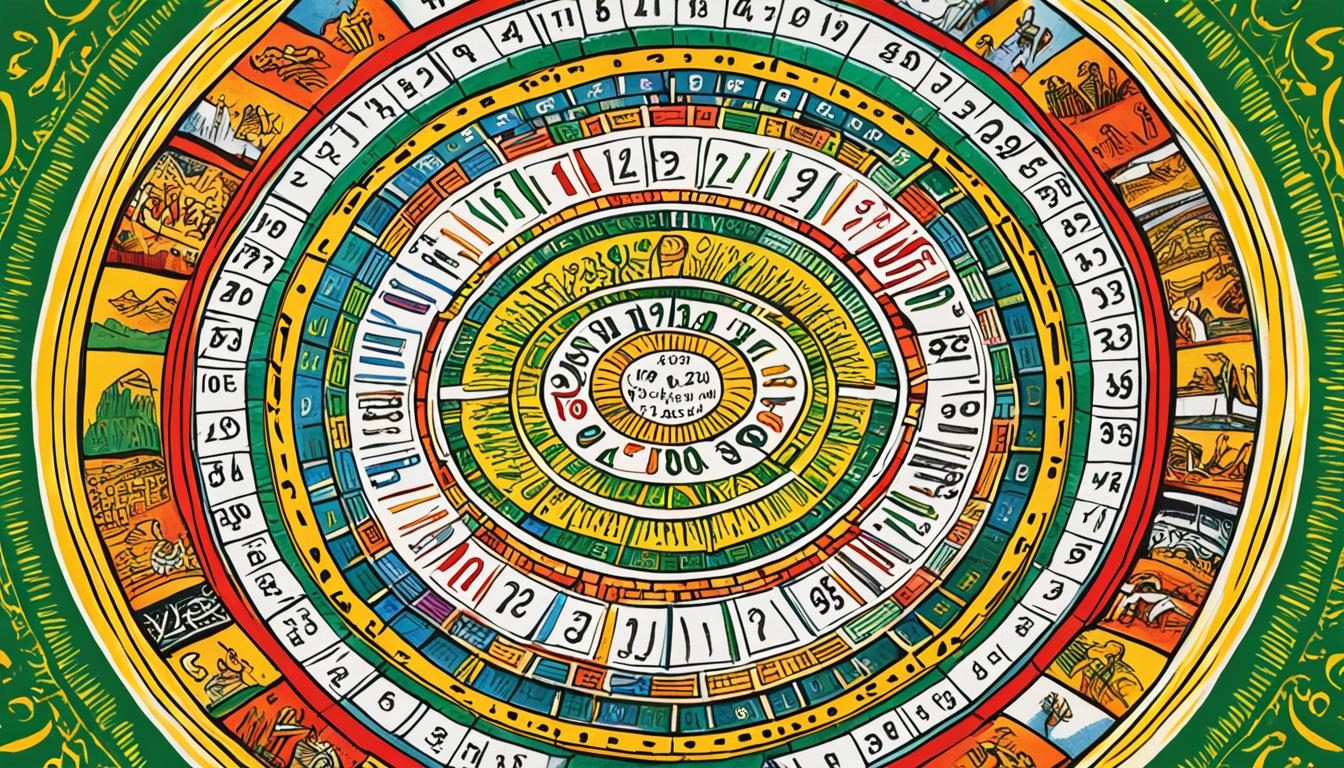Does Ethiopia Have 13 Months?
Yes, you read that right. While most of the world follows the standard 12-month Gregorian calendar, Ethiopia has its own unique calendar system that includes an extra month. This fascinating fact about the Ethiopian calendar unveils a rich cultural heritage and highlights the country’s distinct approach to timekeeping.
The Ethiopian calendar, also known as the Ge’ez Calendar, is based on the ancient Coptic Calendar. It is seven to eight years behind the Gregorian calendar due to alternate calculations in determining the date of the annunciation of the birth of Jesus. The Ethiopian calendar consists of 12 months of 30 days each, with an additional five or six days known as the 13th month added at the end of the year to match the solar cycle.
Key Takeaways:
- Ethiopia follows a calendar system with 13 months, unlike the standard 12-month Gregorian calendar.
- The Ethiopian calendar is based on the ancient Coptic Calendar and is seven to eight years behind the Gregorian calendar.
- The additional month in the Ethiopian calendar, known as the 13th month or “Pagume,” helps align the calendar with the solar cycle.
- The Ethiopian calendar holds significant cultural and religious importance for the people of Ethiopia.
- The unique time system in Ethiopia is also different from international standards, with Ethiopian time typically being eight hours ahead of Eastern Standard Time in the United States.
The Unique Ethiopian Calendar
The Ethiopian calendar, known as the Ge’ez Calendar, is the official calendar of Ethiopia. It is also used as the ecclesiastical calendar for the Ethiopian Orthodox Tewahedo Church and other Eastern Christian denominations in Ethiopia and Eritrea. It is a solar calendar that shares similarities with the Coptic calendar. The Ethiopian calendar consists of twelve months, each with thirty days, and an additional thirteenth month known as “Pagume.” The names of the months in the Ethiopian calendar, such as Meskerem, Tikimt, and Tahsas, are in Ge’ez, the ancient language of Ethiopia.
The Ethiopian calendar system is a fascinating representation of Ethiopia’s rich cultural heritage. With its unique structure and language, it provides a distinctive way of marking time within the country. The use of Ge’ez, an ancient language, for naming the months adds a historical and traditional touch to the calendar.
“The Ethiopian calendar is not only a way to keep track of time but also a reflection of our cultural identity and religious practices. It serves as a unifying force and a reminder of our unique heritage.” – Ato Yonas, Ethiopian Historian
The Ethiopian calendar reflects the country’s close connection to its religious traditions. Many Ethiopian festivals and holidays are tied to specific months in the calendar, emphasizing the importance of religion in Ethiopian society. It also plays a significant role in determining agricultural seasons and religious events.
Overall, the Ethiopian calendar system is a testament to the country’s cultural richness and the deep-rooted traditions that continue to be cherished and celebrated.
Ethiopian Calendar vs. Gregorian Calendar

When comparing the Ethiopian calendar to the Gregorian calendar, several key differences emerge. Firstly, the Ethiopian calendar is approximately seven to eight years behind the Gregorian calendar. For example, in the year 2021 according to the Gregorian calendar, the Ethiopian calendar would correspond to the years 2014 or 2013. This variation stems from alternate calculations used in determining the date of the annunciation of the birth of Jesus.
An additional distinction lies in the number of months the two calendars encompass. While the Gregorian calendar consists of 12 months, the Ethiopian calendar boasts 13 months. The extra month, known as “Pagume,” is added at the end of the year to align the calendar with the solar cycle. This concept of a 13th month is unique to the Ethiopian calendar and contributes to its distinctiveness.
To further illustrate the difference in calendar systems, events that occur in Ethiopia may have different corresponding dates when converted to the Gregorian calendar. This variance adds an additional layer of complexity when considering scheduling and planning across these different time systems.
Here is a comparison between the Ethiopian calendar and the Gregorian calendar:
| Ethiopian Calendar | Gregorian Calendar |
|---|---|
| Consists of 13 months | Consists of 12 months |
| Months have 30 days each | Months have varying numbers of days |
| Additional 5 or 6 days in the 13th month | Additional days vary by year |
| Follows the ancient Coptic Calendar | Follows the Gregorian reform |
The comparison above highlights some of the fundamental disparities between the Ethiopian calendar and the Gregorian calendar. Despite these differences, both calendar systems play significant roles in respective societies and have their own unique historical and cultural significance.
Timekeeping in Ethiopia

In addition to having a unique calendar, Ethiopia also follows its own time system. The Ethiopia time system plays a vital role in scheduling meetings and events with people in Ethiopia. Understanding the time difference is crucial to ensure effective communication and coordination.
The standard time in Ethiopia is usually eight hours ahead of Eastern Standard Time (EST) in the United States. However, during Daylight Saving Time in the US, the time difference reduces to seven hours. It is important to keep these time variations in mind when planning virtual or in-person interactions with colleagues, partners, or friends in Ethiopia.
Moreover, the Ethiopian day is divided into two 12-hour slots, starting from 06:00. Interestingly, both midday and midnight in Ethiopian time are referred to as “six o’clock.” This unique time system adds to the cultural richness and distinctiveness of Ethiopia.
Here’s a summary of the Ethiopia time system:
- Standard time: Eight hours ahead of Eastern Standard Time (EST)
- Daylight Saving Time: Seven hours ahead of Eastern Standard Time (EST)
- Day division: Two 12-hour slots, starting from 06:00
Having this knowledge about the Ethiopia time system will facilitate efficient communication and ensure smooth coordination across different time zones. It demonstrates the cultural complexities and diversity that make Ethiopia a fascinating country.
Understanding the Ethiopia time system is essential for effective communication and coordination with individuals in Ethiopia. By acknowledging and respecting the time differences, we can establish productive relationships and navigate scheduling challenges more efficiently.
Ethiopia’s Historical Independence
Ethiopia, the land of ancient civilizations and rich cultural heritage, holds a unique place in African history. It is the only country on the continent that has never been colonized by a European power. While European powers were dividing and colonizing Africa in the late 19th century, Ethiopia stood as a beacon of independence and resistance.
In 1895, Italy attempted to invade Ethiopia, seeking to expand its colonial empire. However, the Ethiopian forces, under the leadership of Emperor Menelik II, bravely defended their homeland and emerged victorious in the historic Battle of Adwa. This remarkable triumph against a European power not only secured Ethiopia’s freedom but also shattered the myth of African inferiority perpetuated by colonial ideologies.
Emperor Menelik II’s success in protecting the sovereignty of Ethiopia became a symbol of African resilience and resistance against European colonialism. It inspired other African nations in their fight for independence and autonomy.
“Ethiopia shall stretch forth her hands unto God.”
Emperor Menelik II’s legacy was carried forward by his successor, Emperor Haile Selassie, who played a pivotal role in promoting pan-Africanism and advocating for African independence. Emperor Haile Selassie’s influential speeches and diplomatic efforts solidified Ethiopia’s position as a leader in the pan-African movement.
The historical independence of Ethiopia stands as a testament to the strength, bravery, and unwavering spirit of its people. It is a reminder of the resilience and determination that define the nation’s identity.
Rastafarianism and Emperor Haile Selassie
Emperor Haile Selassie, the last emperor of Ethiopia, holds a special place in the Rastafarian religion. Rastafarianism emerged in Jamaica in the 1930s, and its followers believe that Haile Selassie is the messiah and the reincarnation of Jesus Christ. This belief stems from a quote by Jamaican black rights leader Marcus Garvey, who prophesied that a black king would be crowned in Africa. When Haile Selassie was coronated as the Emperor of Ethiopia in 1930, many Jamaicans saw it as the fulfillment of Garvey’s prophecy.
The Rastafarian movement was born, and its influence spread through the music of artists like Bob Marley. Though Haile Selassie himself did not embrace the Rastafarian faith, he is revered by Rastafarians around the world as a symbol of African identity and resistance against oppression.
“Don’t forget that the Almighty, who created the world, is our Father. We should, therefore, learn to be guided by Him. It is His picture that is in us. With Him in view, let us conduct ourselves properly, avoid all forms of malice, be upright, and all will be well with us.”
Influence on Music and Culture
The influence of Haile Selassie on Rastafarianism extends beyond religious beliefs. His leadership and advocacy for African unity and independence resonated with Rastafarians, inspiring them to assert their own cultural heritage and fight against oppression. Haile Selassie’s speeches, such as his address to the United Nations in 1963, highlighted the importance of peace, justice, and equality among nations.
Rastafarianism’s connection to Haile Selassie can be seen in the reggae music genre, which emerged in Jamaica during the 1960s. Bob Marley, one of reggae’s most prominent figures, incorporated Rastafarian beliefs and themes of social justice into his music, spreading the message of unity and empowerment.
Preserving Ethiopia’s Cultural Heritage
Emperor Haile Selassie played a significant role in preserving Ethiopia’s cultural heritage. He promoted the preservation of ancient churches, monasteries, and historical sites, recognizing the importance of these cultural landmarks as symbols of Ethiopia’s rich history and identity.
| Ethiopia’s Cultural Heritage | Preservation Efforts |
|---|---|
| Ancient Orthodox Christian traditions | Restoration and maintenance of churches and monasteries |
| Unique tribal traditions and languages | Support for cultural festivals and educational programs |
| Ancient rock-hewn churches of Lalibela | Conservation initiatives for long-term preservation |
Emperor Haile Selassie recognized the value of Ethiopia’s cultural heritage and worked to ensure its protection and promotion.
Conclusion
In conclusion, Ethiopia’s calendar system, with its 13 months and unique timekeeping, showcases the country’s rich cultural heritage. The Ethiopian calendar, based on the ancient Coptic Calendar, is distinct from the Gregorian calendar and follows its own calculations in determining dates.
Ethiopia’s historical independence and the resistance against colonization establish it as a symbol of African resilience. The connection between Emperor Haile Selassie and the Rastafarian movement further highlights the cultural significance of Ethiopia in the global community. Through its calendar, history, and cultural contributions, Ethiopia continues to captivate and intrigue people around the world.






